The Basics of Theater Lights
There is no denying the fact that lighting is one of the most important aspects of theater. The correct lights can change the entire atmosphere, tone, and mood on the stage. If you haven’t already worked with the lights before, theater lights can be intimidating to deal with. But, if you look carefully, dealing with the lights in the theater is not much difficult. You need to have a basic knowledge of the lights used in theater, and you are good to go. In this article, we will tell you the basics of theater lights and their correct use. Stay tuned!
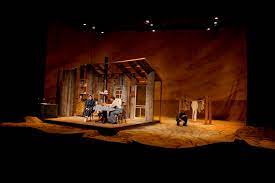
The Basic Functions of Theater Lights
The primary purpose of theater lights is to leave an awe-inspiring impression on the people who came to watch the show. The good news is that you don’t need to be an expert in lights to light up your first show in the theater. All you need is the knowledge of the functions of the lights used in theater. Some of the main functions of theater lights are mentioned below. Let’s check them out.
1. Illuminate the Actors and the Set
The primary function of theater lights is to enable the audience to see the actors and the set. If the audience cannot see the actors clearly, they will not understand anything they are performing. That’s because the actions, moods, and words that the actors portray are delivered from their facial expressions. For this reason, theater lights must be used to illuminate the entire set and the actors performing on the stage. It is not difficult to light up the show in a small space. But, when the place gets bigger, you need to make sure that you use correct lighting so that the audience can have a great time.
2. Change the Time and Environment
The most important thing to understand here is that theater lights are not just illuminating the stage and the actors. Otherwise, everyone just put up some floodlights on the stage from the hardware store. The function of lights in theater is much more than that. It is almost impossible for the set designer to change the time of the day on stage completely. This is where theater lights can help you. If you want to set the environment to nighttime, you can easily use blue lights. On the other hand, warm colors depict daytime.
3. Set the Mood
In addition to highlighting the audience and changing the time of the day, theater lights also can set the mood of the play. This is impossible to achieve by mere acting. If you want to portray an intimate scene, you darken the stage and highlight the actors through the light. If you want the scene to depict brightness and hopefulness, you can use bright lights. Using bright lights will not only set a cheerful mood but will also make the set look larger. What’s more, you can even add some colored lights to match the mood of the musicals.
4. The focus of the Audience
Keeping the focus of the audience throughout the play is extremely important. You must present the play to them so that they follow every sequence of the events on the stage. This is where theater lighting can aid you. You can use these lights to establish the focus of the audience. If you want to convey the transition from one scene to another, you can even cut off the lights on one part and illuminate the area where the next scene will take place. This will convey the message to the audience that they should now look on the other side of the stage.
5. Create the layers
A captivating stage performance has layers. You can add layers to the performance with the help of stage lighting. You can easily use stage lights to paint a picture on the stage. In this way, you will not need to use any props either. All you will need to use are the excellent stage lights, and you are good to go. Furthermore, you can even use it to create a landscape or an environment if you do not already have prepared scenery.
Some Helpful Tips for Starting With Theater Lights
A lot of people think that working with the theater lights is an uphill struggle. But, this is not the case. Whether you are new or old in the field, stage lights are effortless to work with. But, if you still need some assistance with theater lighting, we have some helpful tips for you below. Let’s take a look at them.
1. Learn About the Main Lights Used In Theater
If you have no basic knowledge of the lights used in theater, how will you work with them? Therefore, it is imperative to learn about the main types of lights that the designers use in theaters. You should know about the lights and their parts and the different positions these lights can be used in. Some common types of lights used in theaters are floodlights, spotlights, Fresnel lights, and strobe lights. You must learn about the essential functions of these lights and when you should use these lights.
2. Customize the Lights Based on the Performance
The most important thing to remember while working with stage lights is that you will often need to customize them. Different performances on the stage have different lighting needs. Therefore, you must know how to customize the lights to fit the specific lighting needs. For example, a dance performance needs simple and adaptable lights to highlight the movement of dancers on the stage. If there is a play going on at the stage, it is advisable to use front lighting. That’s because front lights will better feature the facial expressions and the definition of the actors.
3. Create Lighting Zones
The primary purpose of stage lights is to target specific areas on the stage through different means. For this purpose, you should divide the stage into different zones. When you divide the stage into various zones, the stage becomes more manageable and easier to work with. These zones must be of 8 to 12-foot diameter circles. Make sure that there is a slight overlap between each zone. The most common zones that the designers create are front-stage, back-stage, and mid-stage zone. If you are also having trouble working with the stage, you should also create different lighting zones.
4. Plan the Stage Lighting According to the Script
The primary purpose of stage lighting is to enhance the performance on the stage. This is why you should first understand the nature of the performance before planning any lighting. You can do it by reading the script of the play. When you plan the lighting according to the script, it will help you best reflect the various stages of the performance. Moreover, your lights should highlight the part where your audience should be focusing on. Thus, to achieve all of this, it is essential to go through the script first.
Different Theater Lights and Their Correct Use
The correct use of theater lights can change the entire environment of the stage. For this purpose, it is imperative to know about different stage lights used in theaters. When you know in detail about them, you will be able to utilize them correctly. Let’s check out some of the theater lights below.
Spotlights
The spotlight is the most well-known type of light used in theaters. You can use the spotlight to highlight an element or character on stage. Using the spotlights with the color filters will provide you with even more special effects. Whether you want to separate the character from the backdrop or highlight the character or the element on the stage, you can easily do it with the help of the spotlight. This is why you must have seen the spotlights on the actors when they are delivering the dialogue or the emotion.
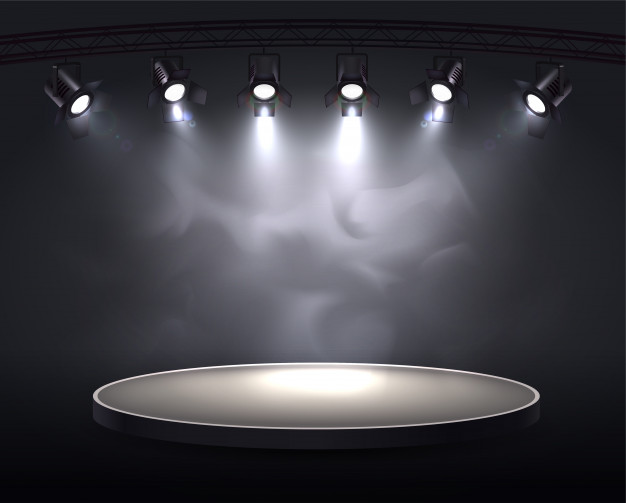
Fresnel Lights
Fresnel lights have a relatively softer edge than spotlights. As a result, you get more control over the angle of the beam as compared to floodlights. These lights are typically used for background lighting or top lighting. The great thing about these lights is that they are portable and highly durable. If you want to get an overall good lighting effect, you should use it with other Fresnel lights.
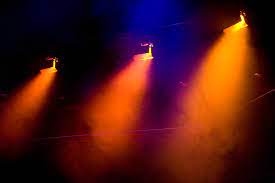
What’s more, you can use Fresnel lights with color filters as well. This will surely grab the attention of the audience. Don’t know how to operate a Fresnel light? Well, you don’t need to worry. These lights are straightforward to use, and you can quickly master them.
Strobe Lights
A strobe light is a flashing light. These lights work by allowing the audience to see the object only a few times a second. If you want to add special effects to your performance, you can easily do it with the help of strobe lights. Apart from this, you can even use these lights to recreate the feel of old movies. If you want to portray a jerky movement of the actors on the stage, these lights are the perfect option. You can even decorate your prop with several strobe lights to make it stand out, among other things present on the stage.
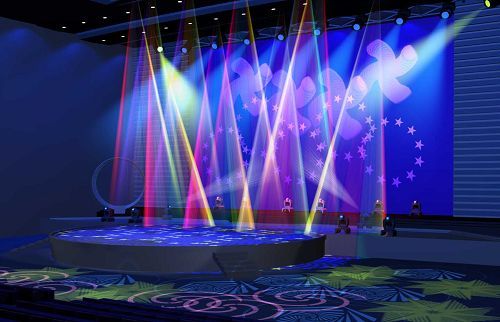
Floodlights
If you want the lights on the stage at a wide angle, then the floodlights are the perfect choice for you. They will give you one of the most wide-angled and clear lights. By comparison, these lights are pieces of equipment used in theaters. A lot of people in theaters use them with colored gels as well. The critical thing to remember here is that the colored gels will perish more quickly when used with floodlights. That’s because of the high temperature of the floodlights. Another drawback of using floodlights in theater is that you get very little control over the spread of the light.
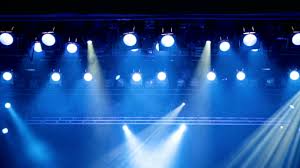
The Main Components of Theater Lights Equipment
Want to know more in detail about the main components of theater lights? Let’s take a look at what is inside these lights and what makes them work so perfectly.
1. Arc Lamps
The most essential thing in the stage lights is the light source. The light source needs to be highly efficient. While regular stage lighting lamps are not much efficient, arc lamps are highly efficient. But, they require a unique power supply to work efficiently.
2. Prisms
You will find prisms and other effects in theater lights as well. The primary function of the prisms is to divide the light into multiple beams. As a result, the whole stage lights up with various beams of light coming out from the stage lights.
3. Adjustable Silk Wheels
The beam and wash fixtures in the stage lights are equipped with adjustable silk wheels and glass frosts. As a result, these lights get the characteristics of a PAR lamp.
4. Strobe Shutter
The strobe lights in the theater consist of a strobe shutter. The primary function of a strobe shutter is to cut out the lights exceptionally quickly. These strobe shutters do not dim at first. They provide quick on and off action to the users.
5. Fixed Color Controller
There is a fixed color controller in different types of theater lights, such as spotlights. This color controller can produce multiple color wheels within the fixture itself. It is filtered through dichroic glass plates in the fixture to create the light. The most prominent advantage of the fixed color controller is that it can produce excellent saturated colors. A typical example of this is Dark Blue and Red color.
6. CMY Color Mixing Controller
Some lights in the theater are also equipped with CMY color mixing controllers. As a result, these lights can use Cyan, Magenta, and Yellow (CMY) colors to produce a vast range of colors. The color mixing controller cannot produce saturated colors the way a fixed color controller can do.
7. Gobos
Gobos is a highly effective technology used in some of the theater lights. This technology provides a lighting effect on the stage. For this, the manufacturers install gobos in moving spotlights. Mostly, gobo patterns are punched around in a fixed gobo rotating wheel. Nowadays, more advanced gobos are evolving as well to provide more intricate designs to the users.
8. Dimming Shutter
All the stage lights require an intensity controller. This is where a dimming shutter steps in. The dimming shutters are placed at the front head of the moving lights used in theaters. A motor controls these dimming shutters, and they control the intensity of the stage lights.
9. Moving Lenses
Focus and zoom are essential functions of theater lights. These functions are controlled by moving lenses in stage lights. Some of the moving lights are equipped with beam-shaping shutters as well. This allows the lights to angle the edges even from a remote location.
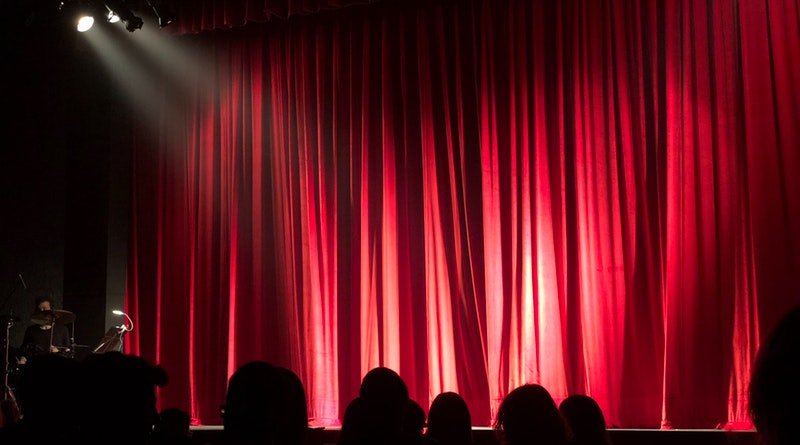
Different Theater Lights Position for You
There are different positions in which you can use the theater lights. It all depends upon your creativity and ideas. But, most of the stage lighting designers focus on the five central positions. Want to know what those positions are? Keep reading then.
1. Front Lighting
Front lighting is the primary source of lighting in theaters. These lights are positioned explicitly in the rigs to provide visibility to the audience. Mostly, the lights are hung in the front position of the theater, such as beam positions, trusses, or over the head of the audience. But, make sure that you do not place too many lights in the front. Otherwise, it will flatten out the other three-dimensional shapes. This is why it is crucial to balance the front lights in the theater with other lights. You must use enough lights to make the actors and the set on the stage visible, but you need to balance it with different angles.
2. Back Lighting
The lights that are hung behind the actors on the set are known as backlighting. Backlighting is helpful to create an impactful environment around the actors. It also gives depth to the actors by helping them stand out from the background. If the designer uses the backlight alone, it creates a halo effect on the stage. The objects or the actors that face the stage are blackened out, and a bright outline of their shapes is left behind. If you mix other angles of lights, such as side and front lighting, with the backlights, you will make the actors and objects pop out from the background.
3. Side Lighting
Side lighting is another critical theater lighting position. This position is used to give shape to the people on the stage. There are different types of side lighting as well. Some common side lighting examples are High Sides, Low Sides, and Dance Sides. High Sides is the lighting position that gives the designers an excellent hybrid system to provide both visibility and shape to the audience and objects on the stage. Low Sides, also known as Pipe Ends is a standard angle positioned at the end of the stage. This position is used to free up the middle of the batten space. As a result, the top and backlights get more coverage. Dance Sides is a lighting position where the lights are hung on vertical booms at the side of the stage.
4. Down Lighting
Down lighting is also known as foot lighting. This lighting position is one of the oldest positions that the designers are using even before using electric lights. Earlier, candles were placed on the stage to light up the set. Some designers even placed the candles behind the jar of colored water to give the colored light effect to the stage. Nowadays, down lights are used to illuminate the area on the stage with a soft or harsh light.
5. High-Side Lighting
High-side lighting is also a significant lighting position. The designers place the lights on the top of the actor’s head, neck, and shoulders. This enables the audience to see the facial expressions of the performers easily. This is why it is one of the most crucial lighting positions used by designers. It allows the audience to connect on a deeper level with the actors on the stage.
Final Thoughts
Theater lighting plays a critical role in highlighting and enhancing the performance on the stage. For this purpose, you must have a basic knowledge of these lights and their correct use.
For More Information, Contact Us Today!



